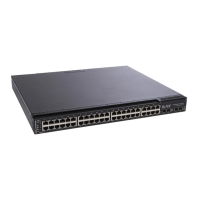100 RackSwitch G8000: Application Guide
The features of this VLAN are described in the following table.
Note: VLAN tagging is required only on ports that are connected to other switches
or on ports that connect to tag-capable end-stations, such as servers with
VLAN-tagging adapters.
Table 11. Multiple VLANs Example
Component Description
G8000 switch This switch is configured with three VLANs that represent three
different IP subnets. Five ports are connected downstream to
servers. Two ports are connected upstream to routing switches.
Uplink ports are members of all three VLANs, with VLAN
tagging enabled.
Server 1 This server is a member of VLAN 1 and has presence in only
one IP subnet. The associated switch port is only a member of
VLAN 1, so tagging is disabled.
Server 2 This server is a member of VLAN 1 and has presence in only
one IP subnet. The associated switch port is only a member of
VLAN 1, so tagging is disabled.
Server 3 This server belongs to VLAN 2, and it is logically in the same IP
subnet as Server 5. The associated switch port has tagging
disabled.
Server 4 A member of VLAN 3, this server can communicate only with
other servers via a router. The associated switch port has
tagging disabled.
Server 5 A member of VLAN 1 and VLAN 2, this server can
communicate only with Server 1, Server 2, and Server 3. The
associated switch port has tagging enabled.
Enterprise
Routing switches
These switches must have all three VLANs (VLAN 1, 2, 3)
configured. They can communicate with Server 1, Server 2, and
Server 5 via VLAN 1. They can communicate with Server 3 and
Server 5 via VLAN 2. They can communicate with Server 4 via
VLAN 3. Tagging on switch ports is enabled.

